As a marketer, staying on top of content demands can feel like a constant uphill battle. Your audience keeps asking for more, and keeping up with that demand is almost a full-time commitment. But what if there was a technology that could ease the pressure and give you a significant competitive edge? That’s where Retrieval-Augmented Generation (RAG) in marketing comes in.
Let me explain what RAG is and, more importantly, how it can transform your marketing strategy in ways you might not have expected.
Retrieval-Augmented Generation (RAG) in Marketing

Retrieval-Augmented Generation, or RAG for short, is a cutting-edge AI technology making waves in the marketing world. But what exactly is it, and why should you care? RAG is a hybrid approach that combines the power of large language models with the ability to retrieve and incorporate external information. Think of it as giving your AI assistant a massive, constantly updated library of knowledge from which to draw.
The importance of RAG in marketing can’t be overstated. In an era where content is king, RAG allows marketers to create highly relevant, accurate, and personalized content at scale. It’s not just about churning out more content. We need to produce smarter, more targeted material that resonates with your audience. By leveraging RAG, you can tap into a wealth of up-to-date information, ensuring your marketing efforts are always on point and ahead of the curve.
But RAG is more than just a fancy tool for content creation. It’s a game-changer for market research, customer insights, and strategic decision-making. Imagine having an AI assistant that can sift through mountains of data, extract meaningful patterns, and provide you with actionable insights in real-time. That’s the power of RAG, and it’s transforming the way marketers approach their craft.
The Intersection of RAG and Marketing Strategies
Now that we’ve covered the basics, let’s explore how RAG intersects with marketing strategies. RAG can enhance virtually every aspect of your marketing efforts, from content creation to customer segmentation, making it the Swiss Army knife of marketing tools.
One of RAG’s most exciting marketing applications is content personalization. By leveraging this solution, you can create hyper-targeted content that speaks directly to individual customer segments. This level of personalization was once a pipe dream requiring enormous resources and manpower. Now, it’s not only possible but scalable with RAG.
The technology also excels at market analysis and trend forecasting. By continuously retrieving and analyzing vast amounts of data, RAG-powered systems can identify emerging trends, predict market shifts, and help you stay ahead of the competition. This predictive capability allows marketers to be proactive rather than reactive, shaping strategies based on solid data rather than gut feelings.
Moreover, RAG is revolutionizing customer service and engagement. Chatbots and virtual assistants powered by this technology provide more accurate, context-aware responses to customer queries. This improves customer satisfaction and frees up human resources for more complex tasks.
The intersection of RAG and marketing strategies is where data meets creativity, and AI meets human insight. It’s a powerful combination that’s reshaping the marketing landscape by offering unprecedented opportunities for those willing to embrace it. As we continue, you’ll discover just how transformative this technology can be for your marketing efforts.
Comprehensive Overview of RAG Components
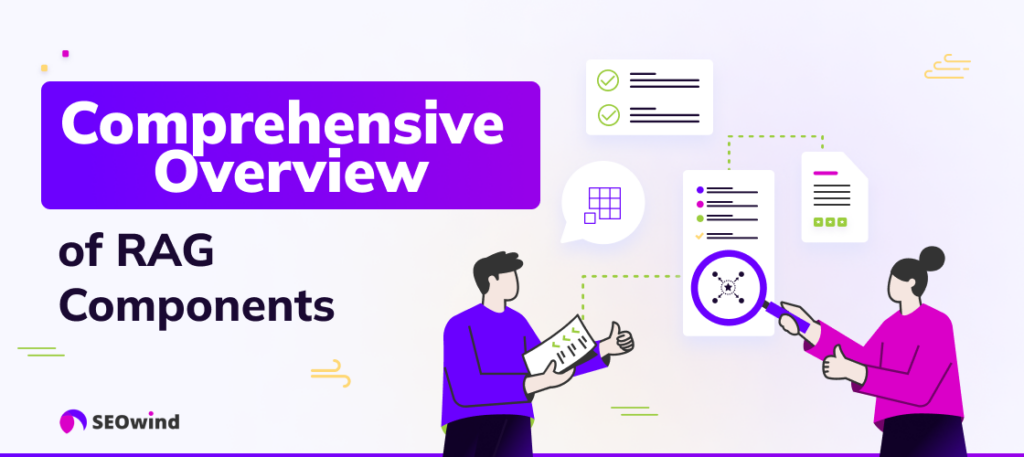
Understanding the components and inner workings is crucial. To that end, let’s examine the technology that powers this innovative approach and the key features that make it so valuable for marketers.
The Technology Behind RAG: How It Works
At its core, RAG combines two powerful technologies: a retrieval system and a language model. The retrieval system acts as a vast, intelligent database, while the language model serves as the creative engine. Here’s how they work together:
- Information Retrieval: When given a query or task, the RAG system first searches its extensive knowledge base for relevant information. This includes websites, documents, databases, and other sources of information.
- Context Selection: The system selects the most pertinent information from the retrieved data. This step is crucial for ensuring the final output is relevant and accurate.
- Augmentation: The selected information is fed into the language model as additional context. This process augments the model’s existing knowledge, allowing it to generate more informed and accurate responses.
- Generation: Finally, the language model uses its inherent knowledge and augmented information to generate the desired output, whether that is a piece of content, an answer to a question, or a marketing strategy.
This process happens in real time, allowing RAG to provide up-to-date, context-aware responses based on a vast knowledge pool. This combination of retrieval and generation sets RAG apart from traditional AI models and makes it powerful for marketing applications.
Key Features of RAG Tools
RAG tools come with a suite of features that make them indispensable for modern marketing strategies. Here are some of the key features you can expect:
- Dynamic Knowledge Integration: RAG tools can continuously update their knowledge base, ensuring that the information they use is always current and relevant.
- Contextual Understanding: These tools grasp the context of queries and tasks, providing more accurate and nuanced responses than traditional AI models.
- Scalability: RAG systems can handle vast amounts of data and generate content at scale, making them ideal for large-scale marketing campaigns.
- Customizability: Many RAG tools allow for customization, enabling marketers to tailor the system to their needs and industry.
- Multi-modal Capabilities: Advanced RAG tools can work with various types of data, including text, images, and even audio, providing a comprehensive solution for diverse marketing needs.
- Analytics and Insights: RAG tools often come with built-in analytics features, helping marketers track performance and gain insights from the generated content.
- Integration with Existing Systems: Many RAG tools are designed to integrate seamlessly with existing marketing tech stacks, enhancing rather than replacing current workflows.
By leveraging these features, marketers can improve their strategies, creating more targeted, relevant, and effective campaigns.
Advantages of Utilizing RAG in Marketing Efforts
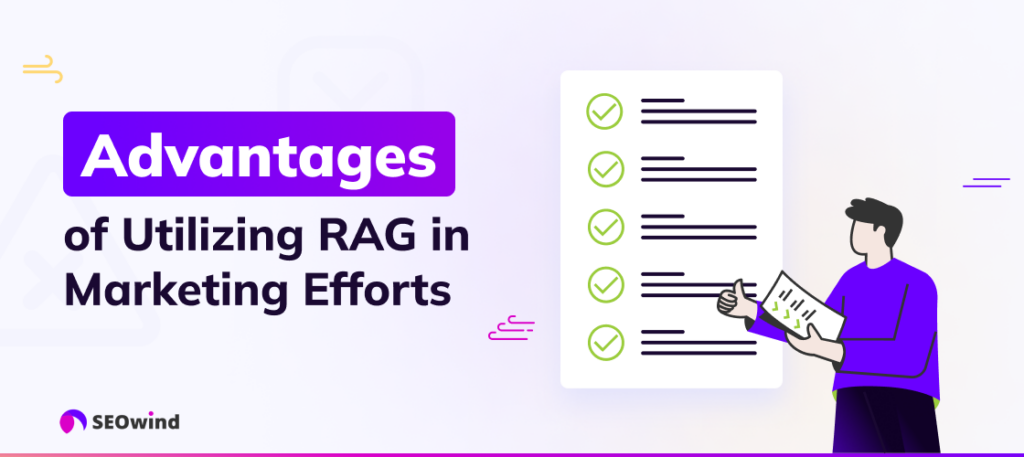
Marketers are constantly seeking ways to stay ahead of the curve. RAG offers a powerful solution to many of our challenges.
Increasing Content Precision and Relevance
One of RAG’s most significant benefits is its ability to produce highly precise and relevant content. By leveraging vast amounts of up-to-date information, RAG ensures that your marketing materials are always on point. This is particularly crucial in industries where accuracy is paramount.
For instance, SEOwind, a long-form AI Writer, utilizes RAG technology to create comprehensive and high-quality content based on thorough SEO and content research. This approach allows marketers to craft articles that resonate with their target audience and drive traffic by addressing their niche’s most current and relevant topics.
The precision offered by RAG means you can create content that speaks directly to your audience’s needs and interests, increasing engagement and conversion rates. It’s like having a team of expert researchers working around the clock to ensure your content is always cutting-edge and valuable.
Personalizing Customer Experiences at Scale
Personalization is expected. RAG technology enables marketers to deliver personalized experiences to their customers at an unprecedented scale. By analyzing vast amounts of data and understanding individual preferences, RAG can help create tailored content for different segments of your audience.
SEOwind’s approach to personalization is a prime example of this process. The platform allows users to define their tone of voice and input information about their companies, services, and target audience. This ensures that AI-generated content reflects your brand’s unique voice and speaks directly to your ideal customers.
By leveraging RAG for personalization, you can create more meaningful connections with your audience, improve customer satisfaction, and drive better marketing results.
Streamlining Marketing Workflow for Efficiency
Efficiency is key in marketing, and RAG can significantly streamline your workflow. By automating time-consuming tasks like research and initial content creation, RAG frees up your team to focus on high-level strategy and creative tasks that require a human touch.
SEOwind’s CyborgMethod™ exemplifies this efficient collaboration between humans and AI. Their platform handles 80% of the work through research and AI writing, allowing marketers to focus on refining and personalizing the content. This approach saves time and ensures that the final product benefits from AI efficiency and human creativity.
Integrating RAG into your marketing workflow can reduce the time spent on repetitive tasks, accelerate your content production cycle, and ultimately achieve more with your existing resources.
Achieving Scalable Content Production
One of the most challenging aspects of content marketing is maintaining quality while scaling up production. RAG technology offers a solution to this dilemma by enabling the creation of high-quality content at scale.
SEOwind’s platform is a testament to this capability, allowing marketers to create 5x more high-quality AI content. By combining RAG with Multi-Agent AI, SEOwind simulates a human marketing team, including a data researcher, SEO specialist, content writer, and content editor. This approach ensures that each piece of content is well-researched, SEO-optimized, and polished, all at a scale that would be impossible with a purely human team.
The scalability RAG offers means you can maintain a consistent content output even when your marketing needs grow. Whether you’re updating old content or creating new articles, RAG technology ensures you can meet the demands of your content calendar without sacrificing quality.
By leveraging the power of RAG in your marketing efforts, your business is positioned at the forefront of your industry. This technology’s precision, personalization, efficiency, and scalability can transform your marketing strategy, helping you achieve better results and drive meaningful growth for your business.
Detailed Guide to Implementing RAG within Marketing Strategies
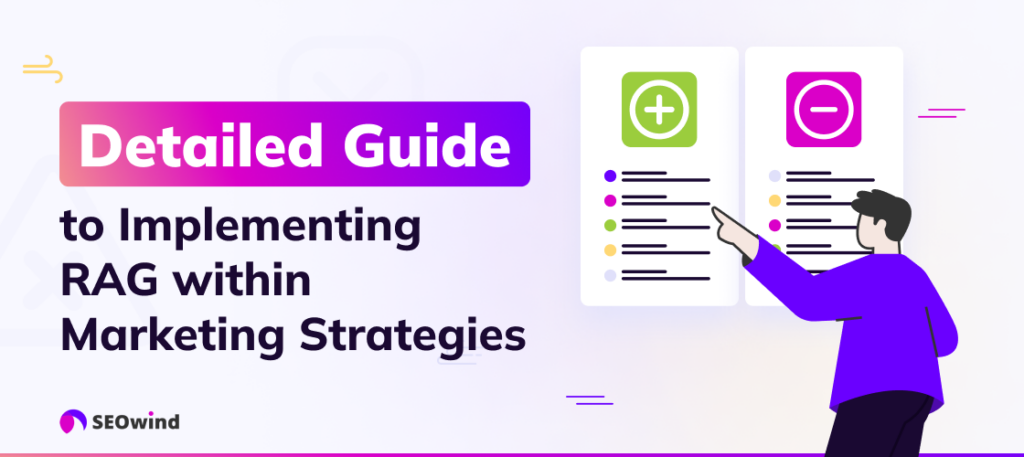
Implementing RAG in your marketing strategy can be a game-changer but requires careful planning and execution. This guide will walk you through the essential steps to successfully integrate RAG into your marketing efforts.
Evaluating Organizational Needs for RAG Implementation
Before diving into RAG implementation, assessing your organization’s specific needs and goals is crucial. Start by asking yourself:
- What are your current content creation challenges?
- Which areas of your marketing strategy could benefit most from AI assistance?
- What are your scalability requirements?
- How much personalization do you need in your content?
Answering these questions clearly shows where RAG can make the most significant impact. For instance, if you’re struggling to create large volumes of SEO-optimized content, a tool like SEOwind might be an ideal solution.
RAG isn’t a one-size-fits-all solution. Your implementation should be tailored to your unique needs and objectives.
Selection Process for the Right RAG Tools and Platforms
Choosing the right RAG tool is crucial for successful implementation. Here’s a step-by-step process to help you make an informed decision:
- Research available options: Look into various RAG tools and platforms.
- Evaluate features: Compare each tool’s features to your organizational needs. For example, SEOwind offers comprehensive SEO and content research capabilities, which might be crucial for your strategy.
- Consider integration capabilities: Ensure the tool can integrate seamlessly with your existing marketing tech stack.
- Assess customization options: Look for platforms that allow you to define your tone of voice and incorporate company-specific information.
- Check for scalability: Ensure the tool can grow with your needs. SEOwind, for instance, boasts the ability to create 5x more high-quality AI content.
- Trial period: Take advantage of free trials or demos to get hands-on experience with the tools whenever possible.
Integrating RAG with Current Marketing Systems
Once you’ve selected your RAG tool, the next step is integration. Here’s how to ensure a smooth process:
- Identify integration points: Determine where RAG will fit into your current workflow. Will it be used for content creation, customer service, or both?
- Data migration: If necessary, prepare to migrate relevant data to your new RAG system.
- API integration: Work with your IT team or the RAG tool provider to set up any necessary API connections.
- Test runs: Conduct thorough testing to ensure the RAG tool is working correctly with your existing systems.
- Gradual implementation: Consider a phased approach, starting with one area of your marketing efforts before expanding.
Best Practices for Training the Marketing Team on RAG Use
For RAG to be effective, your team has to know how to use it properly. Here are some best practices for training:
- Comprehensive onboarding: Provide thorough training on the RAG tool’s features and capabilities.
- Hands-on practice: Allow team members to experiment with the tool in a low-stakes environment.
- Use case scenarios: Develop specific use cases relevant to your marketing strategy and practice applying RAG to these scenarios.
- Continuous learning: Set up regular check-ins and refresher courses to keep the team updated on new features and best practices.
- Encourage collaboration: Encourage team members to share tips and tricks to foster a culture of continuous improvement.
Tips for Effective Monitoring, Optimization, and Scaling
To get the most out of your RAG implementation, follow these tips:
- Set clear KPIs: Establish metrics to measure the success of your RAG implementation, such as content output, engagement rates, or time saved.
- Regular performance reviews: Conduct periodic assessments of your tool’s performance against your KPIs.
- Feedback loop: Encourage your team to provide regular feedback on the tool’s effectiveness and any challenges they face.
- Stay updated: Keep abreast of updates and new features in your RAG tool.
- Gradual scaling: As you become more comfortable with RAG, gradually increase its use across different marketing functions.
- Optimize prompts: Continuously refine your prompts to get better results from the RAG system.
- Blend human creativity: Remember that RAG is a tool to augment human creativity, not replace it. Encourage your team to add their unique insights and creativity to RAG-generated content.
By following this guide, you’ll be well on your way to successfully implementing RAG in your marketing strategies. The key to success is a thoughtful, strategic approach that aligns RAG capabilities with your specific organizational needs and goals.
How SEOwind uses RAG to write quality content
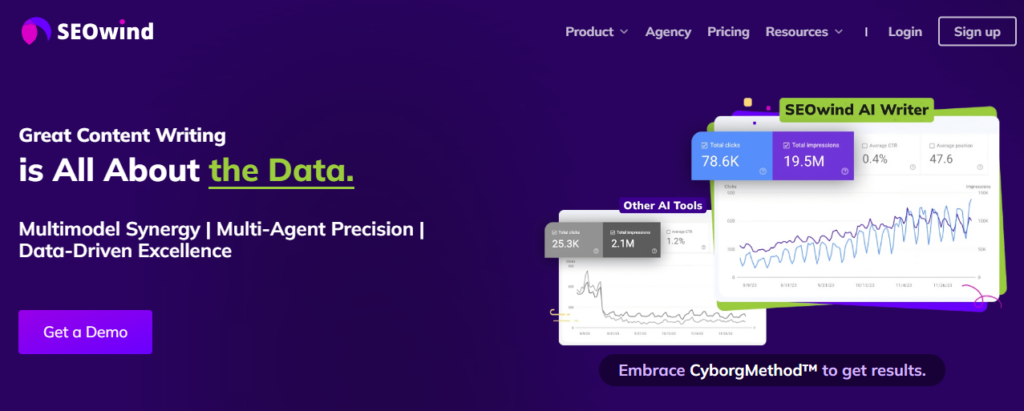
SEOwind has revolutionized content creation by combining RAG (Retrieval-Augmented Generation) technology with a unique methodology that prioritizes research. Their fundamental belief is that research constitutes 80% of effective content creation, with AI writing serving as the final component.
The Power of Multi-Agent AI System
SEOwind’s platform simulates a complete marketing team through its multi-agent AI approach. This system integrates various AI models, including Claude 3.5, Gemini 1.5 Pro, and GPT-4, to handle different aspects of content creation. Each AI “agent” plays a specific role, from data research to content editing, ensuring a comprehensive approach to content development.
Research-First Content Development
The platform begins with extensive content and keyword research, analyzing current SEO trends, competitor content, and industry-specific information. This thorough research process ensures that all content meets Google’s Experience, Expertise, Authoritativeness, and Trustworthiness (E-E-A-T) standards while remaining relevant to search engines.
Personalization and Brand Voice
What sets SEOwind apart is its ability to maintain a brand’s unique voice. Users can define their tone and provide specific information about their company, services, and target audience. This personalization ensures that AI-generated content authentically represents the brand while effectively communicating with the intended audience.
The CyborgMethod™ and Continuous Improvement
SEOwind’s CyborgMethod™ emphasizes the importance of human-AI collaboration. While the RAG system handles research and initial content creation, human input remains crucial for refinement and personalization. The system continuously learns from SEO trends, performance data, and user feedback, ensuring content stays current and effective.
Scalable Content Solutions
Through this sophisticated implementation of RAG technology, SEOwind enables users to create five times more high-quality content compared to traditional methods. The platform not only excels at creating new content but also efficiently updates existing content, maintaining the relevance and SEO optimization of entire content libraries.
This comprehensive approach to content creation demonstrates how RAG technology can be leveraged to produce engaging, SEO-optimized content that drives traffic while maintaining the nuanced understanding typically associated with human content creators. full potential in the content marketing world. The result is more and better content in the form of articles that drive traffic, engage readers, and help businesses achieve their marketing goals.
Future Trajectories: What Lies Ahead for RAG in Marketing?
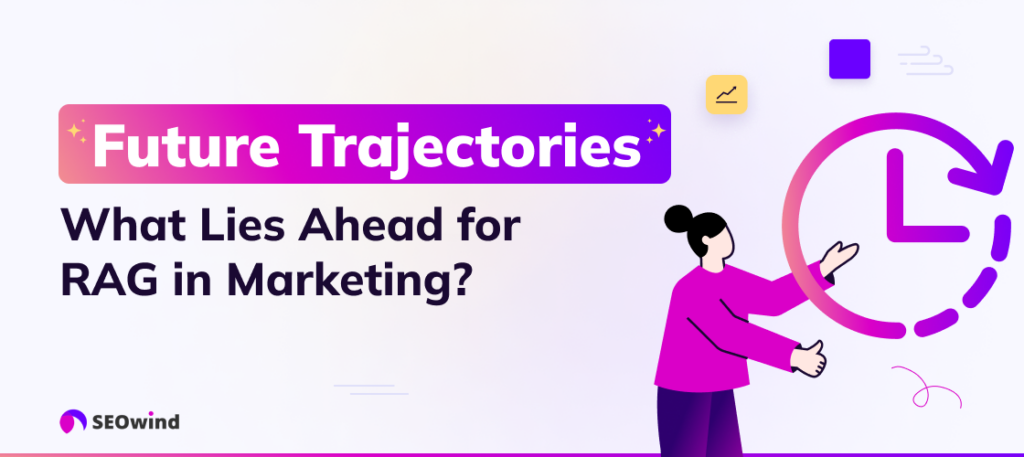
RAG is poised to play an increasingly pivotal role in the development of marketing technology. The technology’s future is brimming with potential, promising to reshape how we approach content creation, customer engagement, and data-driven decision-making.
Key Technologies and Trends to Watch
- Enhanced Natural Language Processing: As RAG systems evolve, we can expect significant improvements in natural language processing. This will lead to even more human-like content generation and AI writers capable of understanding and replicating nuanced tones, cultural references, and industry-specific jargon with unprecedented accuracy.
- Real-time Content Adaptation: Future RAG systems will likely be able to adapt content in real time based on user interactions and changing contexts. Imagine marketing materials that automatically adjust their messaging, tone, or language based on real-time user behavior and preferences.
- Multi-modal RAG: While current RAG systems primarily focus on text, the future will likely see the integration of multiple modalities. RAG could soon generate and manipulate images, videos, and interactive content, creating a truly immersive marketing experience.
- Hyper-personalization at Scale: As RAG systems become more sophisticated at processing and interpreting vast amounts of data, we’ll see a new level of personalization in marketing. Campaigns will be tailored to individual customers, taking into account their entire interaction history and preferences.
- Predictive Marketing Insights: RAG systems will likely evolve to not just retrieve and generate content, but also to predict future trends and customer behaviors. This could revolutionize marketing strategy, allowing for proactive rather than reactive campaigns.
- Ethical AI and Transparency: As RAG becomes more prevalent in marketing, we expect an increased focus on ethical AI practices and transparency. Future systems may include built-in safeguards against bias and mechanisms to explain their decision-making processes.
Potential Growth Areas and Emerging Applications
Enhanced Customer Interaction and Personalization
RAG enables brands to engage customers on a personal level with tailored content, adaptable customer service, and culturally relevant global outreach.
- Dynamic E-commerce Experiences: RAG could transform e-commerce by creating dynamic product descriptions, personalized recommendations, and even virtual shopping assistants that adapt their communication style to each customer.
- Intelligent Customer Service: RAG-powered chatbots and virtual assistants could provide increasingly sophisticated customer service, handling complex queries and even anticipating customer needs before they’re expressed.
- Localization and Global Marketing: RAG systems might revolutionize global marketing efforts by providing culturally nuanced translations and adaptations of marketing materials, making it easier for brands to expand into new markets.
Automated and Scalable Content Management
With RAG, brands can automate content creation, distribution, and compliance, streamlining workflows and reducing the need for constant manual adjustments.
- Automated Content Ecosystems: Imagine a marketing ecosystem where RAG creates content, manages its distribution, monitors its performance, and iterates based on results, all with minimal human intervention.
- Predictive Content Calendars: RAG could analyze historical data, current trends, and predictive models to suggest optimal content topics and publishing schedules, maximizing engagement and ROI.
- Regulatory Compliance: In industries with strict regulatory requirements, RAG could ensure marketing materials always comply with the latest regulations, automatically updating content as rules change.
Data-Driven Strategy and Brand Optimization
RAG provides insights that allow brands to refine influencer strategies, monitor brand sentiment, and create optimized content for emerging platforms like AR and voice.
- Influencer Marketing Optimization: RAG could analyze influencer content and audience engagement to help brands identify the most effective partnerships and even generate tailored content briefs for influencers.
- Voice and Audio Marketing: As voice search and audio content continue to grow, RAG could play a crucial role in optimizing content for these formats, including generating scripts for podcasts or voice ads.
- Augmented Reality (AR) Content Creation: RAG could assist in creating dynamic, context-aware content for AR marketing experiences, enhancing engagement and interactivity.
- Sentiment Analysis and Reputation Management: Advanced RAG systems could monitor and analyze brand sentiment across various platforms in real time, helping companies quickly address issues and capitalize on positive trends.
As these technologies and applications evolve, marketers who embrace RAG will find themselves at the forefront of innovation, capable of creating more engaging, personalized, and effective marketing campaigns than ever before. The future of RAG in marketing is primarily focused on augmenting human creativity and strategy with powerful, data-driven insights and capabilities.
The most successful marketers will be those who learn to effectively collaborate with RAG systems, using them as tools to enhance their creativity and strategic thinking rather than replace them entirely.
Challenges of RAG for Marketing

While RAG offers immense marketing potential, it’s not without its challenges and limitations. Understanding these hurdles and developing strategies to overcome them is crucial for marketers who want to leverage RAG effectively.
Data Quality and Management
The foundation of any successful RAG system lies in its data. Without high-quality, relevant information, even the most sophisticated system will fall short of expectations.
- Challenge: RAG systems’ effectiveness depends heavily on data quality and relevance. Inaccurate or outdated information can compromise content generation.
- Solution:
- Implement regular data audits and updates
- Establish robust data governance practices
- Develop systematic quality control measures
Technical Integration and Complexity
Implementing new technology into existing systems is never straightforward, and RAG integration presents its own unique set of technical hurdles.
- Challenge: Incorporating RAG into existing marketing systems requires significant technical expertise and resources.
- Solution:
- Adopt a phased implementation approach
- Partner with experienced RAG technology providers
- Start with smaller projects before scaling up
Ethical Considerations and Content Authenticity
As AI-generated content becomes more prevalent, questions about ethics, transparency, and authenticity move to the forefront of marketing discussions.
- Challenge: Concerns about AI-generated content, transparency, and potential bias persist.
- Solution:
- Develop clear ethical guidelines
- Implement content verification processes
- Maintain transparency about AI usage
- Create disclosure policies
Human-AI Balance
Finding the right balance between artificial intelligence and human creativity is crucial for maintaining authentic, effective marketing strategies.
- Challenge: Risk of overreliance on AI, potentially diminishing human creativity and strategic thinking.
- Solution:
- Foster collaborative approaches combining AI and human expertise
- Use RAG as an enhancement tool, not a replacement
- Implement feedback loops for continuous improvement
Regulatory Compliance
The marketing landscape is increasingly regulated, making compliance a critical consideration in RAG implementation.
- Challenge: Ensuring RAG-generated content meets various marketing regulations, especially in regulated industries.
- Solution:
- Stay updated on AI and marketing regulations
- Consult legal experts for compliance guidance
- Develop industry-specific compliance frameworks
Cost Management
While RAG can offer significant long-term benefits, the initial investment and ongoing costs can be substantial, requiring careful financial planning.
- Challenge: High implementation and maintenance costs, particularly challenging for smaller businesses.
- Solution:
- Conduct thorough cost-benefit analyses
- Start with affordable RAG solutions
- Scale gradually based on ROI
- Consider custom RAG models for specific needs
Keeping Pace with Technology
The rapid evolution of AI technology creates both opportunities and challenges for organizations implementing RAG systems.
- Challenge: Rapid evolution of AI technology makes it difficult to stay current with latest capabilities.
- Solution:
- Foster a culture of continuous learning
- Regular team training and development
- Stay connected with industry developments
- Leverage analytical capabilities for trend identification
Future Outlook
The landscape of RAG technology continues to evolve rapidly, offering both new opportunities and challenges. As the technology matures, we can expect to see:
- Improved algorithms
- More sophisticated data handling
- Evolving best practices
- Enhanced integration capabilities
Success in RAG implementation depends on maintaining a balanced approach that combines technological innovation with human expertise while staying adaptable to changing market demands. Organizations that can effectively navigate these challenges while leveraging the solutions available will be best positioned to realize the full potential of RAG in their marketing efforts.
List of Tools, Platforms, and Services for Getting Started with RAG
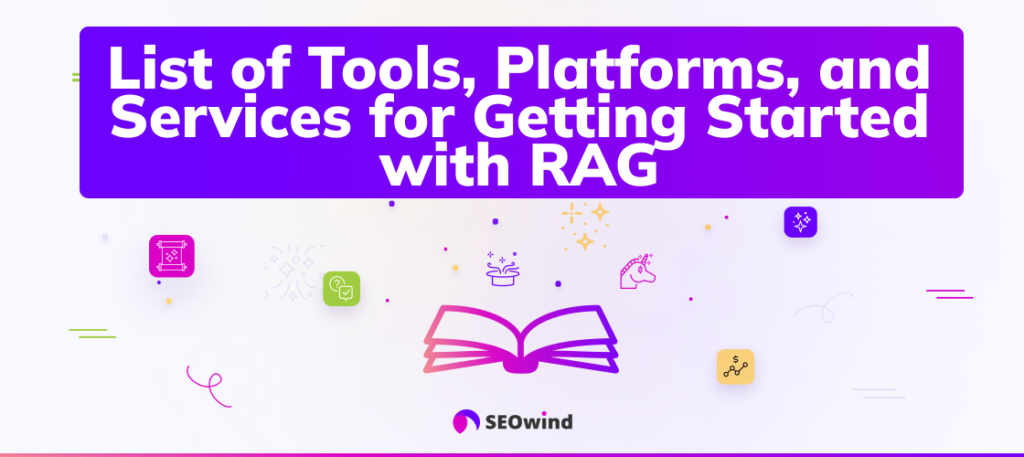
As RAG continues to gain traction in the marketing world, a variety of tools, platforms, and services have emerged to help businesses harness its power. Whether you’re just starting out or looking to enhance your existing RAG capabilities, here’s a comprehensive list of resources to consider:
- SEOwind: SEOwind offers a powerful solution for marketers looking to generate high-quality, SEO-optimized content at scale. Its unique approach combines RAG with Multi-Agent AI, simulating an entire marketing team to create comprehensive, traffic-driving articles. SEOwind’s platform allows for in-depth content and keyword research, content outline and brief creation, and updating existing content. It’s particularly useful for those seeking to maintain a consistent brand voice while leveraging AI capabilities.
- OpenAI’s GPT-4: While not exclusively a RAG tool, GPT-4 can be integrated into RAG systems to enhance language generation capabilities.
- Google’s BERT and T5: These models can be used as the foundation for building custom RAG systems, which is especially valuable for businesses with specific domain knowledge requirements.
- Hugging Face Transformers: This open-source library provides access to various pre-trained models that can be used in RAG implementations.
- Elasticsearch: While primarily known as a search engine, Elasticsearch can be integrated into RAG systems to enhance retrieval capabilities.
- Apache Lucene: Another powerful search engine that can be used to build the retrieval component of a RAG system.
- Facebook’s RAG: Facebook has open-sourced its own RAG implementation, which can be a good starting point for developers looking to build custom solutions.
- Pinecone: As a vector database that enhances RAG systems’ retrieval capabilities, Pinecone is particularly useful for handling large-scale data.
- Weaviate: An open-source vector database that can be integrated into RAG systems for improved search and retrieval.
- LangChain: A framework for developing applications powered by language models that can be used to build custom RAG solutions.
- Haystack: An open-source framework for building search systems that can be adapted for RAG implementations.
- Rasa: While primarily known for chatbots, Rasa’s open-source machine learning tools can be adapted for RAG systems in conversational marketing.
- Anthropic’s Claude: Another AI model that can be integrated into RAG systems for enhanced language understanding and generation.
- Cohere: Offers AI models and tools that can be used to build RAG systems, with a focus on natural language processing.
- AI21 Labs: Provides language models and tools that can be incorporated into RAG systems for various marketing applications.
When choosing a tool or platform for RAG implementation, it’s essential to consider your specific needs and resources. SEOwind, for instance, offers a comprehensive solution tailored specifically for content marketing and SEO, making it an excellent choice for businesses looking to quickly leverage RAG technology without the need for extensive technical expertise.
For those with more technical resources, combining open-source tools like Hugging Face Transformers with custom retrieval systems built on Elasticsearch or Pinecone could provide a highly customizable solution. Larger enterprises might consider building their own RAG systems using foundational models like GPT-4 or BERT, combined with proprietary data and custom retrieval mechanisms.
Of course, the key to successful RAG implementation isn’t just the tools you choose but how you integrate them into your existing marketing processes and align them with your business goals. As SEOwind demonstrates with its CyborgMethod™, the most effective approach often involves a thoughtful combination of AI capabilities and human expertise.
As you explore these tools and platforms, keep in mind that the field of RAG is rapidly evolving. Stay informed about new developments and be prepared to adapt your toolkit as new technologies and best practices emerge. With the right tools and approach, RAG can significantly enhance your marketing efforts, allowing you to create more engaging, relevant, and compelling content at scale.


